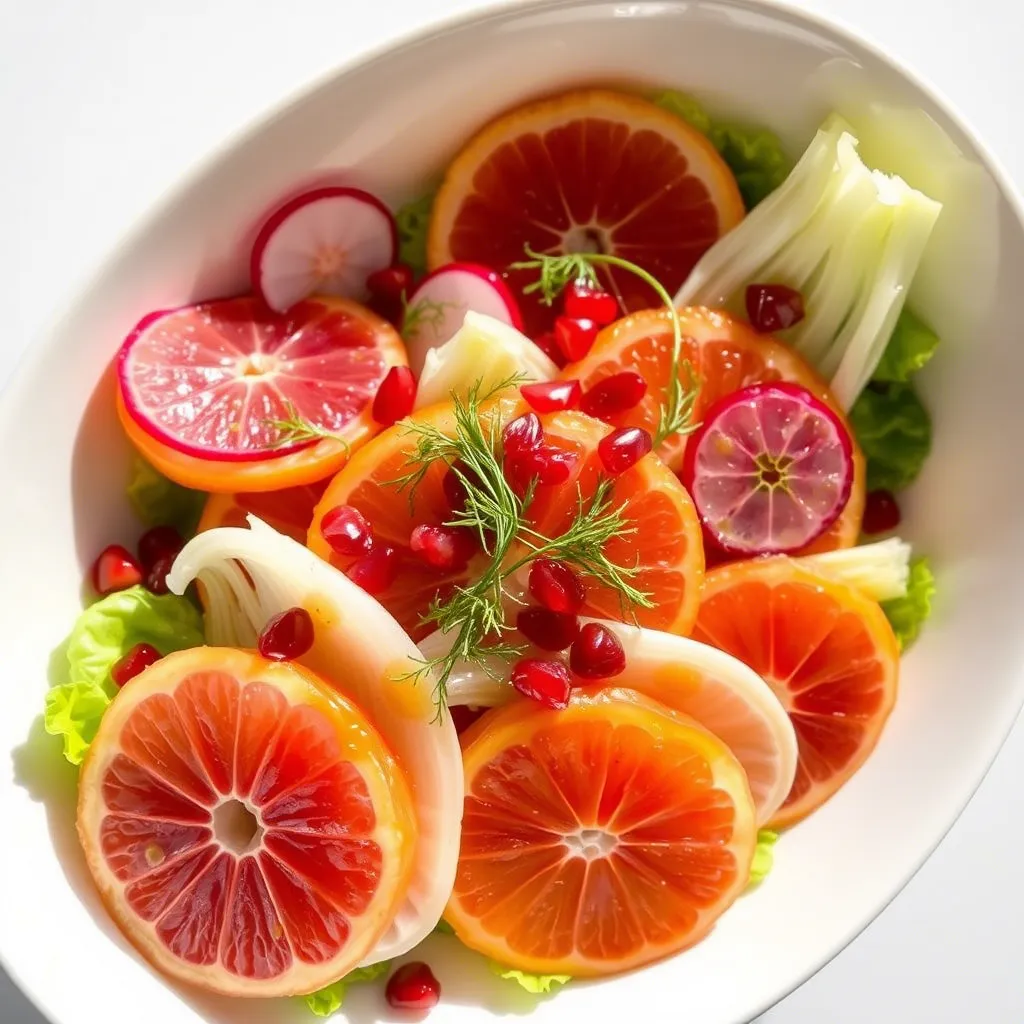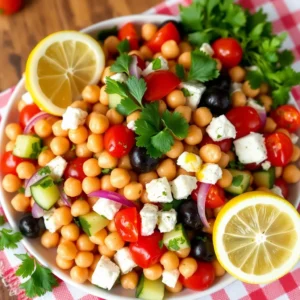Why You’ll Love This Winter Citrus and Fennel Salad
Hello, friends! Alexandre here, and I’m about to brighten your winter days with a splash of sunshine on a plate. When the world outside is gray and chilly, this Winter Citrus and Fennel Salad with Pomegranate steps in like a colorful conversation at a monotonous party!
Let’s face it – winter eating can sometimes feel like we’re stuck in a rut of heavy comfort foods and steaming soups. Don’t get me wrong, I love those too (have you tried my Unbelievably Easy Creamy Tomato Soup?), but sometimes our bodies crave something fresh, vibrant, and alive with flavor.
This winter salad is the answer to those cravings. It’s like finding a $20 bill in your winter coat – an unexpected delight that makes you smile from ear to ear! The bright, juicy citrus segments burst with vitamin C just when your immune system needs it most. The crisp, licorice-scented fennel adds a sophisticated crunch that elevates this from a simple salad to a conversation starter. And those pomegranate jewels? They’re not just gorgeous – they’re little pops of sweetness that dance on your tongue.
What I love most about this salad is how it fits into real life. As a busy home cook myself, I understand the afternoon scramble of getting dinner on the table while helping with homework, answering emails, or squeezing in that load of laundry that’s been sitting there since Tuesday. This citrus fennel creation comes together in just 15 minutes flat – no cooking required! Just some simple slicing and arranging, and you’ve got a restaurant-worthy dish that looks like you spent hours on presentation.
For all you meal-prep warriors out there, you’ll appreciate how the components can be prepared ahead of time and assembled just before serving. The citrus can be segmented, the fennel can be shaved, and the pomegranate seeds can be extracted the day before – all stored separately in the refrigerator until you’re ready to bring them together in harmonious union.
And for those of you with picky eaters at home (I see you, and I’ve been there!), this vibrant display has a way of enticing even reluctant vegetable eaters. There’s something about the rainbow of colors that makes children curious enough to try “just one bite” – which often leads to cleaned plates and requests for seconds!
The versatility of this winter salad also deserves a standing ovation. It can stand alone as a light lunch, accompany a hearty pasta dinner, or even grace your holiday table as a refreshing counterpoint to richer dishes. I’ve served it at casual weeknight dinners and elegant dinner parties alike, and it never fails to impress.
The Story Behind This Winter Citrus and Fennel Salad
This recipe was born on one of those frigid January days when the winter blues had firmly settled into our home. My youngest was complaining about “everything being boring,” my teenager had disappeared into the digital realm of constant texting, and even the dog seemed to sigh more heavily when looking out at the snow-covered yard.
I stood in my kitchen, staring into the refrigerator, hoping for inspiration. In the produce drawer sat some oranges, a grapefruit, and a bulb of fennel I’d picked up on a whim at the farmer’s market. Not exactly the makings of excitement, or so I thought.
The memory of a Mediterranean vacation from years earlier suddenly floated back to me – a seaside lunch in Sicily where the chef had presented a simple plate of sliced oranges drizzled with olive oil and sprinkled with black olives. It had seemed so strange to my American palate at the time, but one bite had converted me forever.
“What if…” I thought, pulling out the citrus and fennel. I remembered the pomegranate sitting on the counter that my daughter had begged for and then promptly forgotten about. As I sliced through the first orange, the fresh scent immediately lifted my mood. By the time I’d arranged everything on the plate, both kids had wandered into the kitchen, drawn by curiosity.
“What’s that?” my little one asked, already reaching for a pomegranate seed.
“It’s sunshine on a plate,” I replied, not realizing how true those words would become in our family.
When my wife arrived home from work that evening, stressed and cold from her commute, her face lit up at the sight of the colorful salad on the table. “This is exactly what I needed,” she said after her first bite.
From that day forward, this Winter Citrus and Fennel Salad became our family’s remedy for the winter doldrums. My kids now ask for it weekly, and I’ve caught my teenager proudly showing a photo of it to friends when discussing “cool food.” The pomegranate seeds have become known as “winter jewels” in our house, and deseed them together has become a cherished kitchen activity on Sunday afternoons.
What began as a refrigerator clean-out experiment has become a symbol of finding brightness in unexpected places. The contrast between the bitter winter outside and the sunny, vibrant plate of citrus creates a kind of poetic balance that reminds us that seasons change, and there’s beauty to be found in each one.
I hope this winter salad brings the same joy to your table as it has to mine. After all, good food isn’t just about nourishing our bodies—it’s about feeding our spirits, creating memories, and finding moments of delight in the everyday.
Ingredients
The beauty of this Winter Citrus and Fennel Salad with Pomegranate lies in its simple, fresh ingredients that come together to create something truly spectacular. Each component plays a vital role in the symphony of flavors, so let’s break them down:
For the Salad Base:
- 1 large fennel bulb (look for one that feels heavy for its size with bright, firm fronds)
- 2 navel oranges (their sweet, reliable nature makes them perfect for this dish)
- 1 ruby red grapefruit (for that perfect tangy counterpoint)
- 1 blood orange (optional, but adds dramatic color and berry-like flavor)
- 1 small shallot (adds a gentle bite that balances the sweet elements)
- ½ cup pomegranate seeds (about half a medium pomegranate)
- 3 cups mixed tender greens like arugula or baby spinach (provides a peppery base)
- ¼ cup fresh mint leaves, torn (for a refreshing brightness)
For the Dressing:
- 3 tablespoons extra virgin olive oil (use the good stuff here, you’ll taste the difference)
- 1 tablespoon white wine vinegar (for gentle acidity)
- 1 teaspoon honey (local if you can find it)
- 1 teaspoon Dijon mustard (helps emulsify the dressing and adds complexity)
- Zest of 1 lemon (captures the aromatic oils for maximum flavor)
- Salt and freshly ground black pepper to taste
Optional Garnishes:
- ¼ cup toasted pistachios or sliced almonds (for crunch and protein)
- 2 ounces crumbled goat cheese or feta (for creamy richness)
- 1 avocado, sliced (adds creamy texture and healthy fats)
Now, let’s talk substitutions because we all know that sometimes the grocery store is out of exactly what we need, or perhaps someone in your household has dietary restrictions:
If fennel isn’t your thing or you can’t find it, thinly sliced celery can provide a similar crunch, though with a different flavor profile. The anise flavor of fennel is unique, but the textural element is what’s most important here.
For the citrus, feel free to use whatever varieties are available to you. Cara Cara oranges, tangerines, or even mandarin oranges work beautifully. The key is to have a mix of sweet and tart for balanced flavor.
No pomegranate? No problem! Dried cranberries soaked in a bit of orange juice will give you that jewel-like appearance and burst of sweetness. Or try fresh raspberries for an equally stunning visual impact.
If you’re avoiding added sugars, the honey can be omitted from the dressing or replaced with a squeeze of orange juice for natural sweetness.
For a dairy-free or vegan version, simply skip the cheese or replace it with a plant-based alternative. The salad is equally delicious without it!
And for those who need to add more substance to make this a complete meal, this winter salad pairs wonderfully with grilled chicken, seared salmon, or roasted chickpeas for plant-based protein.
Execution
Creating this vibrant winter salad is less about cooking and more about thoughtful preparation and arrangement. Here’s how to bring it together with precision and flair:
Step 1: Prepare the Fennel (5 minutes) Begin by trimming the fennel bulb. Cut off the stalks where they meet the bulb (save some of the feathery fronds for garnish) and remove any tough or bruised outer layers. Cut the bulb in half lengthwise and use a sharp knife to carefully remove the triangular core at the base of each half.
Using a mandoline on the thinnest setting (or a very sharp knife and steady hand), shave the fennel into paper-thin slices. Immediately place the shaved fennel in a bowl of ice water, which will crisp it up and help curb its assertive flavor. Let it soak while you prepare the remaining ingredients.
Step 2: Segment the Citrus (5 minutes) Working over a bowl to catch the juices (don’t waste that liquid gold!), use a sharp knife to cut off the top and bottom of each citrus fruit. Following the curve of the fruit, cut away the peel and white pith. Then, holding the fruit in your hand, carefully cut between the membranes to release the segments. Place the segments in a bowl, and save that collected juice for your dressing.
Step 3: Prepare the Pomegranate (if not using pre-seeded) (3 minutes) Cut the pomegranate in half across its equator. Hold one half cut-side down over a bowl of water and whack the back firmly with a wooden spoon. The seeds will fall into the water while the white membranes will float to the top. Skim off the membranes and drain the seeds.
Step 4: Make the Dressing (2 minutes) In a small jar or bowl, combine the olive oil, white wine vinegar, honey, Dijon mustard, lemon zest, and 1 tablespoon of the reserved citrus juice. Add a pinch of salt and a few grinds of black pepper. Shake or whisk vigorously until emulsified.
Step 5: Assemble the Salad (5 minutes) Drain the fennel and pat it dry with paper towels or a clean kitchen towel. Thinly slice the shallot into rings.
On a large platter or individual plates, arrange a bed of the mixed greens. Scatter the shaved fennel and shallot rings over the greens. Artfully arrange the citrus segments on top, varying the colors for visual appeal.
Sprinkle the pomegranate seeds over everything like the precious jewels they are. If using any optional garnishes like nuts or cheese, add them now. Finally, scatter the torn mint leaves throughout.
Drizzle the dressing over the salad just before serving, adding a final sprinkle of salt and pepper and any reserved fennel fronds for garnish.
Visual Cues for Success:
- Your fennel should be so thin that it’s almost translucent
- The citrus segments should be completely free of white pith and membrane
- The finished salad should resemble a colorful mosaic with distinct elements visible
For a magnificent presentation, I like to arrange the citrus in a slightly overlapping pattern, alternating varieties for a color gradient effect. This turns a simple winter salad into an impressive dinner party starter that will have your guests reaching for their phones to capture the beauty before digging in!
For a beautiful external reference on mastering citrus segmentation, check out Serious Eats’ guide to cutting citrus supremes, which provides helpful step-by-step photos for visual learners.
And remember, friends, the beauty of this dish comes from the contrast of textures and colors. Don’t worry if your arrangement isn’t perfect – rustic has its own charm! As I always say, “Perfect is the enemy of delicious.”
Additional Tips
This Winter Citrus and Fennel Salad with Pomegranate is already a showstopper, but let me share some insider tips that will take it from merely delicious to absolutely unforgettable!
Temperature Matters: For the best flavor experience, remove the salad ingredients from the refrigerator about 15-20 minutes before serving. Cold temperatures can dull the vibrant citrus flavors, so allowing everything to come closer to room temperature will let those bright notes shine through. This is a trick I learned from a chef friend in Barcelona who insisted that even the simplest dishes deserve this small but significant attention to detail.
Dressing Distribution: Instead of pouring all the dressing on top of your arranged salad, try tossing just the greens and fennel with about half the dressing before arranging the plate. Then drizzle the remaining dressing over the citrus and pomegranate. This two-step approach ensures that every element gets properly dressed without drowning the more delicate components.
Make-Ahead Strategy: This winter salad can be partially prepped ahead of time, which is a lifesaver during busy weeks. The citrus can be segmented up to 2 days in advance and stored in its juice in an airtight container. The fennel can be shaved and stored in cold water in the refrigerator for up to 24 hours. Pomegranate seeds will keep for several days in a sealed container. Just wait to assemble everything until shortly before serving.
Seasonal Variations: While this is primarily a winter salad, you can adapt it for other seasons. In summer, try peaches or nectarines instead of citrus, with thinly sliced cucumber replacing the fennel. In fall, pears and thinly sliced apples work beautifully with the fennel, perhaps with dried cranberries instead of pomegranate.
Texture Enhancement: For an additional layer of texture, try adding a sprinkle of toasted fennel seeds. Toast them lightly in a dry pan until fragrant, then crush slightly before sprinkling over the finished salad. The seeds echo the flavor of the fennel bulb while adding a delightful crunch.
Plating Like a Pro: For a restaurant-quality presentation, try using a ring mold to build individual portions. Start with dressed greens as the base, then layer fennel, citrus, and finally pomegranate seeds on top. Carefully remove the ring for a perfectly stacked presentation that will impress any dinner guest.
Troubleshooting Bitter Citrus: Occasionally, you might get a grapefruit or blood orange that’s more bitter than expected. If this happens, a light dusting of powdered sugar or an extra drizzle of honey on just the citrus segments can balance the flavors beautifully. It’s a rescue trick that’s saved many a winter salad in my kitchen!
Storage Solutions: If you happen to have leftovers, store the components separately if possible. The dressed greens will start to wilt after a few hours, but undressed, they’ll stay crisp for another day. The citrus and pomegranate mixture can last covered in the refrigerator for up to 2 days, though the vibrant colors may fade slightly.
Wine Pairing: This citrus fennel salad pairs beautifully with a crisp Sauvignon Blanc or a light, dry rosé. The bright acidity in these wines complements the citrus while standing up to the anise notes in the fennel. For a non-alcoholic pairing, try a pomegranate spritzer with a splash of lime.
Serving Suggestions: While this salad can certainly stand alone, it makes a beautiful accompaniment to grilled fish, particularly salmon or sea bass. It also pairs wonderfully with Incredible Smashed Potato Salad for a complete meal that balances fresh and hearty elements.
For a truly impressive spread, serve this winter salad alongside my 7 Secrets to Irresistible Crispy Golden Roasted Potatoes and a simple protein for a meal that feels both special and nourishing.
FAQs
Can I make this Winter Citrus and Fennel Salad ahead of time?
You can prep all the components 1-2 days ahead of time, but I recommend final assembly within an hour of serving for the best texture and flavor. Store citrus segments in their juice, fennel in cold water, and the dressing in a sealed jar in the refrigerator until ready to use.
I’m not a fan of fennel’s licorice flavor. Is there a substitute?
Absolutely! If you’re not fond of fennel’s distinctive flavor, try thinly sliced jicama or celery for a similar crisp texture without the anise notes. Belgian endive also works beautifully, providing a pleasant bitter contrast to the sweet citrus.
How do I pick the best pomegranate for this winter salad?
Look for pomegranates that feel heavy for their size, indicating they’re full of juice. The skin should be firm and taut with a deep red color. Avoid any with soft spots or wrinkled skin. When you tap a ripe pomegranate, it should sound slightly metallic.
My kids aren’t fans of grapefruit. Can I use all oranges instead?
Definitely! This citrus fennel salad is infinitely adaptable. Using all oranges will create a sweeter profile, which kids often prefer. Try mixing navel, Cara Cara, and blood oranges for visual variety without the tartness of grapefruit.
Is there a quick way to seed a pomegranate without making a mess?
The water method I described in the execution section is my favorite low-mess approach. Another option is to score the pomegranate into quarters, then submerge it in a bowl of water while you break it apart and release the seeds. The water prevents juice from spraying and helps separate the seeds from the membrane.
What can I add to make this a complete meal?
To transform this winter salad into a hearty main course, add a protein like grilled chicken, seared scallops, or roasted chickpeas. For a vegetarian option that still packs protein, try adding quinoa and avocado. The bright flavors of the salad can stand up to substantial additions.
How long will leftover pomegranate seeds keep?
Extracted pomegranate seeds will keep in an airtight container in the refrigerator for up to 5 days, making them perfect for meal prep. You can also freeze them on a baking sheet and then transfer to a freezer bag for longer storage—they’ll keep for months and can be used directly from frozen in smoothies or allowed to thaw for salads.
Can I use bottled citrus juice instead of fresh for the dressing?
While you can use bottled juice in a pinch, the flavor difference is noticeable. Fresh citrus juice contains volatile compounds that dissipate quickly after juicing, which is why the taste of freshly squeezed juice is so vibrant compared to bottled versions. For this winter salad, where fresh flavors are the star, I recommend taking the extra minute to use the juice from your segmented fruit.
For more amazing salad inspiration, visit Food Network’s guide to winter salads, which offers creative combinations to keep your winter meals fresh and exciting.
As we wrap up this citrus fennel celebration, remember that winter produce offers us a reminder that brightness exists even in the coldest months. This winter salad isn’t just a recipe—it’s an edible reminder to find joy in seasonal treasures when they come our way. The vibrant colors, crisp textures, and tangy-sweet flavors prove that eating by the season never has to be boring or bland.
So the next time winter blues have you feeling a bit dull, let this pomegranate salad bring some sparkle back to your table. After all, we eat first with our eyes, and this dish is truly a feast for all the senses.
Until next time, happy cooking, my friends! Remember, even the simplest ingredients can create extraordinary memories when prepared with love and shared with those who matter most.



